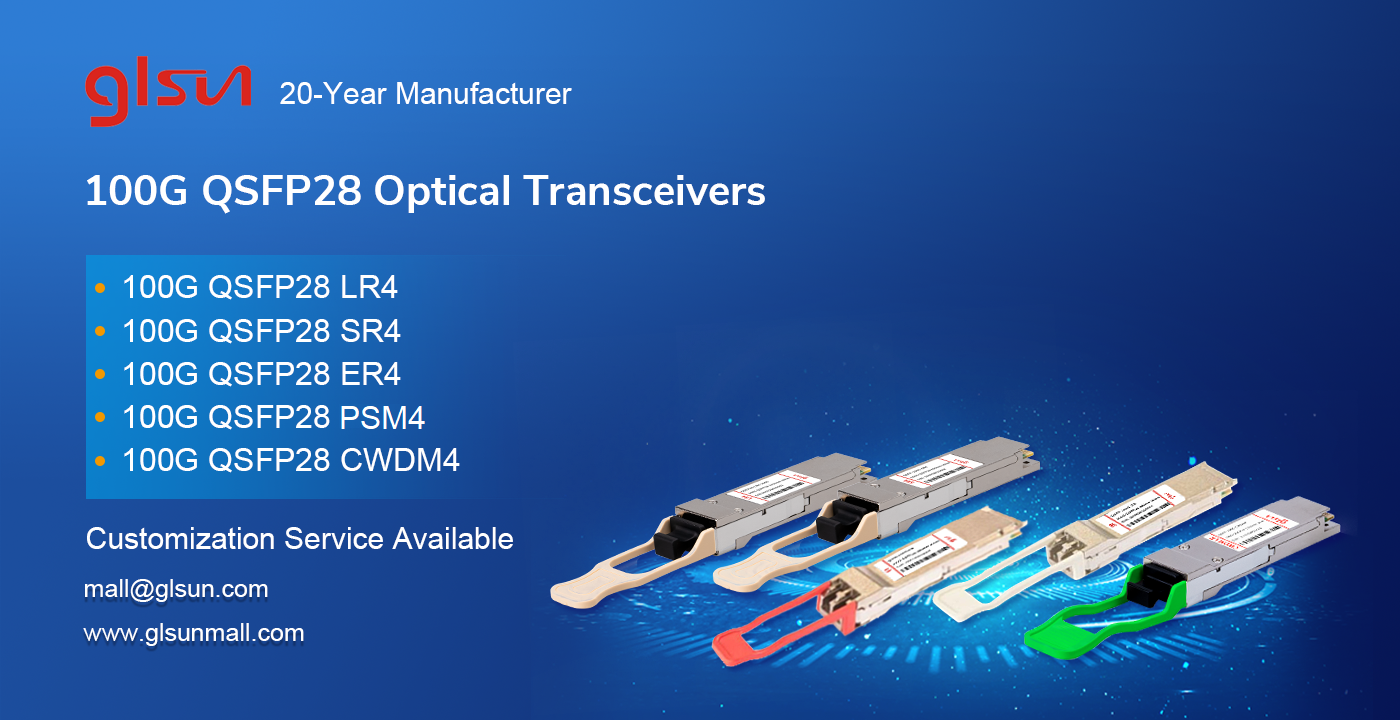Fiber Optic Tech
100G QSFP28 SR4 vs LR4 vs PSM4 vs CWDM4 vs ER4
With the development trends of 100G Ethernet, the demand for 100G optical transceiver module market is increasing, and 100G transceiver modules account for a large proportion of network construction costs in nowadays. What kinds of 100G QSFP28 modules are? What are the differences between them? And how to choose?
What is QSFP28?
100G QSFP28 optical transceiver module is suitable for 100G Ethernet, EDR InfiniBand and 32G Fiber Channel, and generally it has exactly the same volume and panel density as 40G QSFP+. 40G QSFP+ has 4*10Gbps channels, and 100G QSFP28 module is similar to it, adopting 4 high-speed differential signal channels and supports 25Gbps. Its data rate can reach up to 40Gbps. In addition, QSFP28 has an upgraded electrical interface which can support signals up to 28Gbps. Comparing with CFP/CFP2/CFP4, the package type of 100G QSFP28 has higher density, lower power consumption and lower cost advantages.
Standards of 100G QSFP28 Transceiver Module
The standard of 100G QSFP28 optical transceiver module is mainly defined by IEEE and MSA, and IEEE defines the standards for QSFP28 SR4, QSFP28 LR4, QSFP28 ER4. “QSFP” refers to the package type of optical modules. "28" means the maximum transmission rate of 28Gbps per channel. "SR" means short distance (up to 100m). "LR" means long distance (up to 10km). "ER" means extended distance (up to 40km). "4" means the module has 4 channels. For example, QSFP28 SR4 means that this transceiver module can use four wavelengths to transmit 100G signals in a short distance of 100m.
100GBASE-SR4 and 100GBASE-LR4 are the two most common 100G port specifications defined by IEEE, but the transmission distance of QSFP28 SR4 is too short to meet all connection requirements, while the cost of QSFP28 LR4 for large data centers is too high. But, MSA brings new solutions to the medium-distance transmission market, that is, PSM4 and CWDM4 standards. Although QSFP28 LR4 covers the transmission distance of QSFP28 CWDM4, in terms of cost, the cost of CWDM4 is far more affordable and competitive than LR4 in the transmission distance of 2km.
100G QSFP28 Laser Type
Lasers play a huge role in 100G QSFP28 optical transceiver modules. There are five common types of lasers: VCSEL, FP, DFB, DML and EML. These different types of lasers have different working wavelengths, working modes and application environments.
| Laser Type | Wavelength | Working Mode | Transmission Distance |
| VCSEL | 850nm | Surface-Emitting | Less than 200m |
| FP | 1310nm/1550nm | Edge-emitting | 50m~10km |
| DFB | 1310nm/1550nm | Edge-emitting | 40km |
| DML | 1310nm/1550nm | Direct Modulation | 50m~10km |
| EML | 1310nm/1550nm | Electroabsorption Modulation | 40km |
VCSEL lasers features with small size, low power consumption, easy integration, low cost and high coupling efficiency with multimode fibers, and it commonly used in QSFP28 SR4 module. QSFP28 LR4 and ER4 modules are used for long-distance transmission (10km or 40km), requiring the laser to have the characteristics of large eye opening, low dispersion, high extinction ratio and long transmission distance, and the EML laser meets all requirements well. DML lasers can realize signal modulation by modulating the injection current of the laser. The size of the injected current changes the refractive index of the laser active region, so it results in wavelength drift and dispersion. Therefore, DML is not suitable for long-distance transmission and high-speed signal modulation, but it is suitable for QSFP28 PSM4 and QSFP28 CWDM4 modules with a transmission distance of 500m or 2km
100G QSFP28 Transmission Medium and Distance
100G QSFP28 optical transceiver module connects with duplex LC or MTP/MPO-12 connector, and its transmission distance ranging from 70m to 40km. The transmission distance determines the application scenarios, and all QSFP28 modules can be applied to the direct connection and interconnection of enterprise networks or data centers.
| QSFP28 | SR4 | LR4 | PSM4 | CWDM4 | ER4 |
| Standard | IEEE 802.3 | IEEE 802.3 | MSA | MSA | IEEE 802.3 |
| Connector | MTP/MPO | Duplex LC | MTP/MPO | Duplex LC | Duplex LC |
| Fiber Type | MMF | SMF | SMF | SMF | SMF |
| Wavelength | 850nm | 1310nm | 1310nm | 1270nm~1330nm | 1310nm |
| Transmission Distance | 70m/100m | 10km | 500m | 2km | 40km |
| Laser Type | VCSEL | EML | DML/FP | DML | EML |
How to Choose 100G QSFP28 Transceiver Module?
1. When the transmission distance ranges from 5m to 100m, it is recommended to choose the QSFP28 SR4. This type of transceiver module can transmit 70m on OM3 fiber and 100m on OM4 fiber.
2. When the transmission distance ranges from 100m to 2km, you can choose QSFP28 PSM4 or QSFP28 CWDM4 module. The price of CWDM4 is generally higher than that of PSM4, but CWDM4 only needs 2 single-mode fibers for bidirectional transmission, while PSM4 needs 8. Therefore, the overall cost may be more expensive if you use QSFP28 PSM4. Therefore, it is necessary to consider the specific transmission distance before deciding which module to choose in real applications.
3. When the transmission distance ranges from 10km to 40km, you can choose QSFP28 LR4 or QSFP28 ER4, the former can transmit up to 10km, and the latter can transmit up to 40km
In general, 100G QSFP28 has the characteristics of high density and low power consumption. It can not only meet the current network requirements, but also can prepare for future network expansion. It is an ideal solution for large data centers.




















